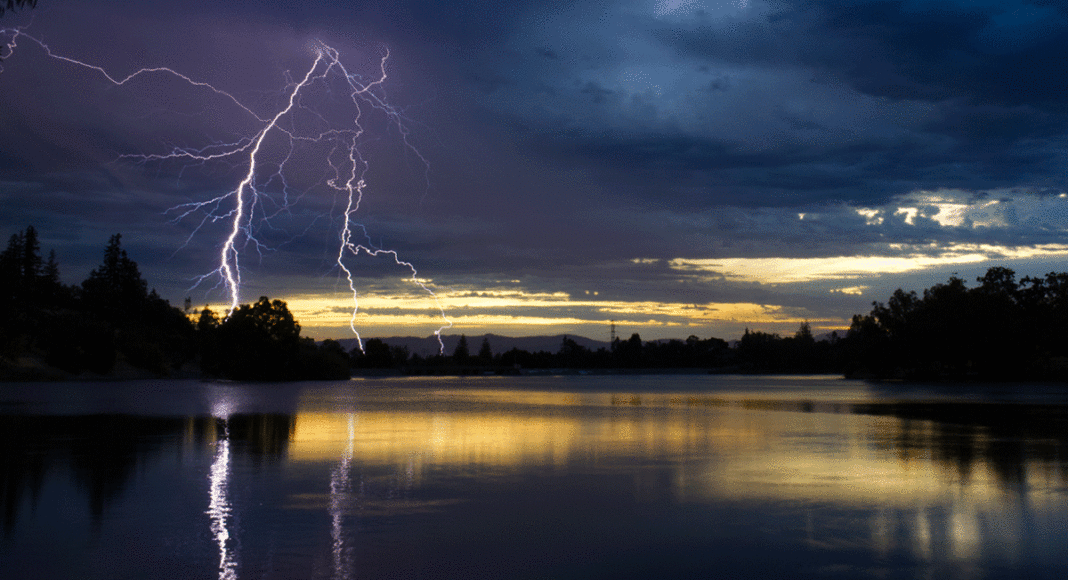UPDATED Tuesday, Aug. 18, 12pm: This article was updated with more information about the heat wave and fires.
Fires popped up around the San Francisco Bay and Monterey Bay areas early Sunday as rare lightning storms struck the area, kicking off a wild week for weather in Northern California and along the Central Coast.
At the end of a day in which temperatures soared higher than 100 degrees in some areas, rolling blackouts began rippling through the state for the second day in a row.
Saturday’s blackouts affected PG&E customers in parts of Monterey, Santa Cruz and San Joaquin counties. In the midst of the nascent heat wave, this past weekend marked the first time since 2001 that the state saw rolling blackouts to conserve energy. The California Independent System Operator (ISO) is asking residents to conserve energy and turn thermostats to 78 degrees or higher during the current heat wave.
The outages are not like the public safety power outages in the past, PG&E said Saturday. Those outages are implemented during California’s fire season when weather conditions threaten to increase the chance of a blaze being lit and spreading quickly.
By 3am Sunday, fierce winds were whipping through Santa Cruz County and lightning began to strike.
The thunderstorms made way for tremendous gusts of wind. Cindy Palmer, a meteorologist at the National Weather Service’s Monetery office, says the thunder clouds were high up in the air—about 5,000 feet. That gap between storms and the earth’s surface allowed wind to pick up speed, with gusts coming in as fast as 60 miles per hour. “It’s just the nature of the storms being high-based,” Palmer says.
Many of the lightning strikes happened out at sea, but others happened on land, often unaccompanied by rain to cool the area. This phenomenon, known as “dry lightning,” often poses very high fire risk. A red-flag warning was in effect Sunday morning from Monterey County to the northern San Francisco Bay Area, according to the National Weather Service.
Summers in this region are normally too dry for thunderstorms, but tropical storm conditions off the coast made this one possible, Palmer says.
Soon sparks started to fly. Cal Fire’s San Mateo-Santa Cruz Unit reported that it responded to at least 22 fires between Sunday morning and Monday at 8am.
Wildfires are now spread across the state of California like polka dots. Two fires in Santa Cruz County—both of them north of Davenport—continue to burn. Larger fires burned in the counties of Monterey, Santa Clara, Contra Costa and Napa. As of Tuesday morning, the River Fire near Salinas was at more than 4,000 acres and 10% contained, while the Canyon Zone Fire in Stanislaus County was 10,000 acres and 0% contained as of Monday night. After a dry winter, this year’s fire season is shaping into one that might last a long time, although Palmer says there’s no timeline for when it will end. “It’s something we’re monitoring,” she says.
A recent Santa Cruz County Grand Jury report found that Santa Cruz County’s fire agencies need to improve communications and that they are unprepared for high fire risk.
Meanwhile, Santa Cruz County officials say residents should expect to experience rotating power outages of 1-3 hours from 3-10pm while the heat wave persists. The state’s energy grid continues to struggle with increased demand because of the ongoing heatwave.
On Monday the ISO issued a statewide Flex Alert, a call for voluntary electricity conservation. The Flex Alert will extend through Wednesday and is in effect from 3-10pm each day.
California’s record-breaking heatwave has put extraordinary strain on the electric system, as air conditioners are working harder and longer to keep spaces cool during the high temperatures, the ISO said.
Between 3-10pm, the ISO is urging consumers to:
- Set air conditioning thermostats to 78 degrees, if health permits
- Defer use of major appliances
- Turn off unnecessary lights
- Unplug unused electrical devices
- Close blinds and drapes
- Use fans when possible
- Limit time the refrigerator door is left open
Additional reporting by Janice Bitters.













